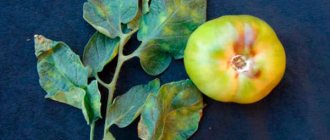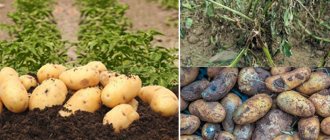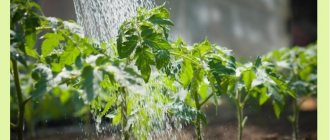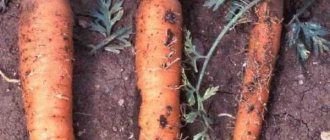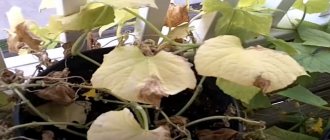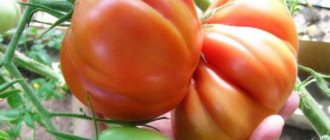Home / Pests and diseases
Back
Published: 06/10/2019
0
Rate this post
A common and quite harmful disease of tomatoes, potatoes and other garden plants, Alternaria annually destroys from a quarter to half of the crop.
Alternaria tomato blight is also known under the following names: dry, brown, early, zonal, concentric spot, macrosporiosis. The causative agent is the simplest mold fungi.
Alternaria alternata and its varieties, of which there are more than 200 species, affect almost all known garden and cereal crops, flowers, trees, rapeseed, tobacco, and cotton. The harvest may be completely ruined.
Alteria fungi also parasitize Formica ants, and also significantly complicate the course of asthma in humans and cause such dangerous diseases as allergic and hypersensitivity pneumonitis, exogenous alveolitis.
- 1 Characteristics of the disease
- 2 What to do
- 3 Preventive measures
What kind of disease is this?
Alternaria blight is a common fungal disease that affects a plant at any stage of its growth. Seedlings get sick less often; more often the disease manifests itself in the initial stage of vegetable ripening. The disease is also called macrosporiosis, dry and brown spot.
The causative agent is the imperfect fungus Alternaria (Macrosporium). When its spores get on the plant, the mycelium begins active growth in the tissues. Most often, the disease occurs in film greenhouses under conditions of poor ventilation and high air humidity.
Potato Alternaria
On potatoes, Alternaria most often appears in mid-June (15-20 days before flowering) and does not allow the plant to rest until autumn. The disease especially “loves” mid-season and mid-late varieties.
The leaves and stems are the first to suffer (dry round brown spots form on them), as a result of which the growth of the potato slows down. Tubers are usually infected during harvesting through contact with fungal spores living on the tops and/or through mechanical damage to the skin. Tubers become covered with dark spots.
Such potato varieties as Dolphin, Dina, Zhivitsa, Lazurit, Lugovskoy, Skarb, Temp are relatively resistant to Alternaria blight.
Description of signs and photos of affected plants
The disease begins on the tips of leaves in the form of dry yellow spots limited by veins. The spots quickly increase in size, merging into one large spot with a clear boundary. Alternaria gradually spreads to branches and fruits. Depressed, elongated spots of a gray-brown hue appear on the stems.
The fungal spores give the affected areas a dark gray color followed by a black coating. On tomatoes, the spots are round, and the black coating on them is much stronger. The affected areas die off.
The symptoms of Alternaria blight are similar to late blight, but the disease begins earlier in the growing season than with late blight. A distinctive feature of Alternaria is the clear limitation of spots and their dryness even in rainy weather.
Here you can see a photo of tomatoes with signs of dry spotting.
Symptoms
The main symptom of the disease is spots on leaves, stems, and fruits. The lower leaves are the first to become marked. The spots have a dark brown color, distinct outlines and a rough coating (these are conidia). The diameter of the marks is from 4 to 14 mm.
Alternaria spots differ from late blight in that they have a dried surface even in rain. Because of this, the disease received the second name “dry spotting”.
On the stems and petioles the spots are elongated, almost black. The marks on the fruit are depressed, dark with a velvety surface, and large. The spot may cover up to a quarter of the surface of the fruit or look like a scattering of small spots collected in groups on the surface of a ripe tomato.
There is a type of fungus that affects not only red but also unripe fruits.
Fruits with spots are unsuitable for food, since the mycelium covers all the pulp and changes its taste. The infection quickly spreads from diseased bushes to healthy ones. Foci of infection form in the garden bed. The epidemic threatens mass death of tomatoes and complete loss of the harvest.
How does macrosporiosis develop on tomatoes and why is it dangerous for them?
The first signs of a fungal disease appear already on seedlings . The disease begins on the lower leaves, as evidenced by small brown spots on the leaf blades, then spreads to the stem, branches and fruits. The stem in the affected part gradually dries out and breaks if the infection is severe.
The disease of the fruit begins with damage to the stalk, and a clear dark spot with a dented skin appears on it. The tomato begins to ripen. The spot enlarges, a red rim appears around it, the fungus penetrates deeper into the tomato pulp and into the seeds.
A tomato affected by Alternaria becomes covered with depressed spots with a black coating. The fruits spoil and fall off the clusters. If measures are not taken in time, the disease will cause the plant to wither and cause significant damage to the crop.
Causes and risk factors
The causes of Alternaria blight on nightshades are:
- Poor ventilation of the greenhouse installation, when it creates high temperature and humidity.
- Constant waterlogging of the soil.
- The presence of abundant morning dew if the plants are in unprotected soil.
- Long rains and cold summers.
The disease is provoked by temperature changes, when the air becomes very hot during the day and a sharp cold snap occurs at night. Moreover, this phenomenon often happens in the non-chernozem zone.
Most often, fungi settle on damaged fruits and other parts of tomatoes. It is known that the causative agents of brown spot do not live in plant debris that has begun to rot.
Treatment
The first signs of Alternaria appear after planting seedlings . Fungi begin to progress during the formation of the ovary. If you take appropriate treatment measures within 3-5 days from the onset of dry spots, the tomato bushes will quickly recover and produce a full harvest.
Agrotechnical methods
Since the pathogenic fungus multiplies quickly in high humidity, gardeners, if possible, reduce the frequency of watering the bushes. Since the fungus damage begins from the lower leaves, to prevent the disease, they are gradually removed. This procedure also promotes free ventilation of the above-ground lower part of the bushes, which is very important for dense cultivation in greenhouses.
The leaves are removed gradually under each formed flower cluster . Leave leaves only in the upper 1/3 of the stem. Trimming the leaves affected at the bottom prevents the fungus from spreading higher up the stem. Ventilation of greenhouses is of great importance, since the disease develops quickly with high humidity and dense planting of tomato bushes in greenhouses with poor air ventilation.
Agronomists recommend changing the site for planting tomatoes every year to restore the nutritional properties of the soil or fertilize it in advance at the beginning of the new season.
Folk remedies
Folk remedies help well in the treatment of Alternaria.
Infusion of potassium permanganate with garlic
Potassium permanganate has a powerful antifungal effect . Essential oils and acids contained in garlic stop the growth and reproduction of pathogenic fungi and cause their death. To prepare the solution:
- take 100 g of chopped garlic, add 200 ml of water and infuse;
- After 24 hours, the solution is filtered, 1 g of potassium permanganate is added and mixed with 10 liters of water.
The resulting solution is sprayed on tomato bushes in the morning and evening every 2 weeks until the signs of the disease disappear.
Ash
Treatment of plants with wood ash is effective. Used by gardeners as a fungicide and insecticide. Tomato bushes are pollinated with ash or the plants are treated with an ash-soap solution. For this:
- A glass of ash is poured into 5 liters of hot water, mixed, filtered and 2 tablespoons of softened laundry soap are added to the solution.
- The solution is shaken until the soap is completely dissolved and the tomato is sprayed.
Treatment is carried out once a week for a month.
Milk and iodine
Treating tomatoes with a solution of milk and iodine has worked well. This combination of components prevents infection by harmful microorganisms. Iodine has disinfecting properties and destroys harmful microorganisms on tomatoes. When sprayed with milk, a film is formed on the treated plants, protecting the plant from damage by pests and fungi.
For treatment, add 1 liter of skim milk and 20 drops of iodine to a bucket of water. Tomatoes are sprayed with the resulting solution every 10-12 days until harvest.
Tomato bushes should be treated with a spray bottle, wetting the plant evenly without missing the underside of the leaves.
Chemicals
Quadris
To treat tomatoes against Alternaria blight, we recommend Quadris, a systemic fungicide . The product penetrates deeply into the plant tissue through the pores of the leaves and blocks the germination of fungal spores. It is used as an effective drug when the first signs of damage appear; its effect decreases when the disease has affected the entire vegetative part of the plant.
- To treat tomatoes grown in open ground, 4 ml of the drug is diluted in 10 liters of water.
- For treatment in greenhouses, 8 ml of fungicide is diluted in 10 liters of water.
Plants are sprayed 2 times per season:
- during the growing season before flowering;
- when the ovary appears.
Repeated treatments are carried out at intervals of 10-12 days. The price of a package with 6 ml of the drug is 20 rubles.
Acrobat MC
Systemic contact fungicide. Release form: water-soluble granules. The active ingredients dimethomorph and mancozeb penetrate the plant tissue and inhibit the development of fungal spores. To prepare the solution, 20 g of fungicide is dissolved in 5 liters of water.
The first spraying treatment is carried out when the first signs of Alternaria appear , repeated treatments are carried out every 2 weeks during the growth of the bush and are stopped a month before harvest. A 100 gram package of Acrobat MC costs 284 rubles.
Maksim
A contact fungicide, the active ingredient of which is fludioxonil, destroys fungi by destroying their cells within 24 hours after treatment. Available in the form of a suspension. 4 ml of the drug is dissolved in 10 liters of water and sprayed on the tomatoes.
The fungicide forms a protective film that prevents the development of pathogenic fungi on plants and planting material.
The drug Maxim has proven itself well as a disinfectant for tomato seeds before planting. The price of 100 ml of fungicide is 300 rubles.
Alternaria blight (dry spotting) of tomatoes briefly about the disease
The causative agent of the disease is an imperfect fungus of the genus Alternaria solani, Macrosporium solani. That is why dry rot of tomato is often called Alternaria.
The fungus can also infect other nightshade crops: eggplants, potatoes, both in open ground and in greenhouses.
What is the danger of the disease
Overwintering on the remains of vegetation damaged last year, the fungus begins its activity as soon as the air temperature reaches 7-10 ᵒC. The optimal temperature for growth and development is considered to be 21-23ᵒC. Further, rising temperatures do not at all prevent the development of the pathogen. Climbing onto the green parts of the tomato plant, it spares neither seedlings nor young bushes. A few days after the introduction of the pathogen, tomatoes:
- slow down growth;
- development deteriorates;
- the functioning of the conduction system and photosynthesis is disrupted.
As a result, the bushes cannot fully gain their genetically determined parameters, flowering is weak, and the ovary grows slowly. Productivity and marketable yield of fruits are reduced.
Attention! The Alternaria fungus attacks tomato bushes at any stage of growth.
Causes
The vegetable grower may not notice the onset of the disease. However, the fungus is found everywhere and, by violating crop rotation and the rules of phytosanitary hygiene, farmers provoke infection of tomato bushes with fungal spores. Being on plant debris and having overwintered, the fungal spores pass into the soil, and then are carried by the wind to the already planted seedlings.
Contribute to the occurrence of the disease:
- alternating moderately warm, hot and humid weather;
- coolness of the night after a hot day;
- morning dew falling;
- close proximity of tomato plantings to a potato plot;
- poor moisture supply. At the same time, tomato leaves droop during the day, and in the evening their turgor is restored. In this case, the plant weakens, resistance decreases, and the bush loses its immune defense.
Attention! Bushes with weakened immunity are the first to be affected by the pathogen.
Particular attention should be paid to crop rotations. When planting a tomato after a potato, the likelihood of damage increases significantly. The soils are full of spores and they reach 100% of tomato bushes.
Symptoms of infection
The fungus affects all above-ground organs and parts of the tomato bush. Depending on the weather and the extent of the damage, signs can vary greatly. On leaf plates the fungus manifests itself as:
- spots of various sizes with a clear limitation;
- spotting is scattered over the entire surface of the leaf;
- a light black coating is a characteristic feature;
- dry roundness with pronounced zonality in the form of colored circles in any weather;
- yellowing and dying of leaves with excessive spotting;
- dryness along the edge of the sheet.
Attention! Alternaria blight can be distinguished from late blight by dry spots and the absence of a fungal fluffy coating on the inside of the leaf. In this case, the damage begins from the lower leaves.
Fruits affected by Alternria will have:
- round spots;
- depressed areas are brown;
- the structure of the stain is dry, with cracks;
- black coating indicating sporulation.
Damage to the tomato stem is indicated by:
- oblong and radial brown lesions;
- deep penetrating introductions of the fungus;
- fractures and fractures of the stem, which inevitably leads to the loss of parts of the plant.
Examining the affected seedlings, the main signs can be observed in the root part of the stem. Black, growing spots are located mainly on the lower part of the stem.
The sepals and peduncles gradually become covered with small, and then quite large, spots for this part of the plant. Then they crack and dry out.
By affecting the shoot and leaf apparatus, the fungus causes yellowing of part or the entire plant, wilting and death. The photo clearly demonstrates Alternaria of tomatoes.
Spread of the disease
Alternaria blight of tomato is widespread. If previously it was possible to describe specific regions, now the fungal infection has taken over the following territories:
- European part of Russia;
- Volga region;
- northwestern regions of Russia;
- North Caucasus;
- Eastern Siberia;
- Southern Urals;
- Far East;
- Moldova;
- Ukraine.
With rare exceptions, some farmers can boast of sanitary cleanliness in relation to Alternaria blight. However, this is more a coincidence than the norm.
Period of disease activity
The Alternaria mushroom is insidious. It does not spare seedlings or plants that have just been planted in open ground.
As soon as the temperature reaches 10-12 ᵒC, the development of mycelium begins. To increase virulence, the pathogen needs:
- above-zero temperatures;
- moisture;
- wind.
All these components exist in nature. That is why Alternaria begins its development earlier than late blight and takes over the seedling period and early fruiting.
Causes and factors contributing to the spread
The pathogen can come from seed material contaminated with fungal spores or come from dry plant residues that have remained in the garden since last season.
Since the weather has not been stable for a long time, pathogenic microorganisms have also intensified their work.
The spread of spores is facilitated by:
- wind;
- rain moisture;
- morning dew;
- temperature variables.
Greenhouse devices that do not have the ability to regulate the microclimate are also susceptible to the manifestation of the disease from the moment the tomato enters the soil.
How to avoid Alternaria
Autumn cleaning of the territory is the basis for success. You cannot give mushrooms a single chance to survive and overwinter in the garden. Plant residues, especially nightshade crops, must be carefully removed from the beds.
Particular attention should be paid to crop rotation. Tomatoes cannot be planted after:
- potatoes;
- pepper;
- eggplant;
- cabbage;
- tomatoes.
It is necessary to return the culture to its original place no earlier than after 3-4 years.
Features of the fight against brown spot in a greenhouse
Growing tomatoes in a confined space with high levels of humidity and temperature promotes the proliferation of fungal pathogens. This is the main reason for the high incidence of tomatoes in the greenhouse. When grown in a greenhouse with poor ventilation, the disease develops much faster than when growing tomatoes in open ground, so plants are treated more often and fungicide solutions with a double dose are used.
When growing tomatoes in open ground, the treatment is repeated after 2 weeks; in closed ground, plants are treated once every 10 days. When vegetables are affected by Alternaria blight in greenhouse conditions, the drugs “Abiga Pik” and “HOM” are used . 0.4% solutions are prepared from these fungicides and the bushes are sprayed throughout the growing season.
In greenhouses, tomatoes are grown in the same place for several years, so before planting the plants, the soil is treated with a solution of copper sulfate or potassium permanganate. To ensure ventilation of the bushes, the lower leaves are removed. For planting, varieties are selected that are less susceptible to Alternaria.
Reasons for appearance
Alternaria blight, or dry spot, is a fungal disease of tomatoes caused by the pathogen Alternaria solani Sorauer. It usually develops in conditions of high humidity and poor air circulation. Most often it affects tomatoes in a greenhouse, but can occur on bushes and in open ground.
The main reasons for the development of Alternaria blight are:
- sharp changes between day and night temperatures;
- high humidity in the greenhouse or heavy dew in open ground;
- frequent changes in weather from very dry and hot to rainy;
- thickened plantings of tomato bushes;
- garden tools infected with fungal spores.
Alternaria usually affects plants that already have mechanical damage to the stems and roots. After this, the fungus quickly spreads to healthy plantings, especially if the tomatoes are located close to each other. In some cases, spores may fall onto the bushes with the wind or spread to the roots of tomatoes from contaminated soil.
Prevention measures
To avoid infection with Alternaria, preventive measures are taken in advance:
- In the fall, after harvesting, the tops and plant remains are burned;
- in greenhouses, the soil in the beds is disinfected or replaced;
- in open ground, alternate planting of tomatoes with other nightshade crops;
- acquire varieties that are less susceptible to the disease;
- fertilize the soil with potassium fertilizers and wood ash;
- Watering is carried out only at the root, avoiding watering on the leaves.
To prevent Alternaria blight, seedlings are sprayed with solutions of biological preparations Trichodermin or Fitosporin.
Treatment of tomato macrosporiosis with fungicides
The best effect will be achieved by using special drugs, and already at an early stage. Against fungal diseases, seedlings and adult plants are sprayed with:
- oxychloride (0.4%);
- Bordeaux mixture (1%);
- Zineb (0.4%);
- Ridomil;
- Polychomos.
Fungicide treatment is applied up to 4 times, but only before harvesting. The last spraying can be carried out no later than 3 weeks before. And in the fall, be sure to treat the area where the infected tomatoes grew with copper sulfate. Otherwise, the fungus will remain in the ground.
Tillage
Since fungal spores are found on the soil surface in plant debris, deep plowing is carried out in the fall after harvesting. At the same time, the organic matter in the soil rots, which contributes to the death of pathogenic fungi that cannot tolerate decay processes.
If there are diseased plants on the site, the soil is disinfected with a 3% solution of Bordeaux mixture, a 2% solution of Oksikhom or copper oxychloride (CHOM), which are protective-contact fungicides of medium toxicity.
For minor infections, safe biological preparations are used: Trichodermin and Fitosporin.
Macrosporiasis. Description of the disease.
It is excited by microorganisms classified by experts in the classification of objects of the organic world as the genus Macrosporium. It is assigned to the family Pleosporaceae, which, along with other 25 families, is covered by the order Pleosporales. This order is included in the class Dothideomycetes, and that class is included in the division Ascomycota, or Ascomycetes, or Marsupial fungi.
The genus Macrosporium (in Russian it can be called a little shorter - Macrosporium) first appeared on the “tablets” of terrestrial biology in 1832 and, as voluminous reference books show, was replenished with new species until 1975 inclusive, so that it currently contains more than 350 species ( taking into account all options and forms).
Species epithets among the “sons” of a genus are often able to remind an attentive person of specific higher plants. Here are a “damn dozen” examples - please compare them yourself:
— Macrosporium abutilonis and the word Abutilon (the name of the genus Abutilon, or Kanatnik); — Macrosporium acalyphae and Acalypha (the name of the genus Akalifa, or Foxtail); — Macrosporium agaves and Agave (name of the genus Agave); — Macrosporium amaranthi and Amaranthus (the name of the genus Amaranth, or Shchiritsa); — Macrosporium amygdale and Amygdalus (name of the subgenus Almond); — Macrosporium avenae and Avena (genus name Oats); — Macrosporium brassicae and Brassica (name of the genus Cabbage); — Macrosporium cheiranthi and Cheiranthus (genus name Zheltushnik); — Macrosporium oleandri and the phrase Nerium oleander (the name of the species Common Oleander); — Macrosporium papaveris and the word Papaver (the name of the genus Poppy); — Macrosporium phaseoli and Phaseolus (the name of the genus Bean); — Macrosporium sesame and Sesamum (genus name Sesame, or Sesame); — Macrosporium violae and Viola (name of the genus Violet)…
It seems quite natural to assume that all plants that are easily associated with similar species epithets should be (at least to a small extent) “familiar” with macrosporiosis. However, it is not confirmed by studying the sources of relevant information. They mainly talk about only three cultures:
A) subspecies and varieties of Potato, or Nightshade (Solanum tuberosum), as well as any varieties of Tomato (Solanum lycopersicum) can develop macrosporiosis “thanks to” the fungus Macrosporium solani. At the same time, only a few authors dare to casually add: “and other plants of the Solanaceae family”;
B) Cotton plants [exactly those 4 species from the genus Gossypium that are spinning: Gossypium arboreum (Tree cotton, also known as Indochinese), Gossypium barbadense (Barbados cotton, also known as Peruvian), Gossypium herbaceum (Herbaceous cotton, also known as Guza) and the most famous in the USSR, Gossypium hirsutum (Common cotton, also known as Mexican, also known as shaggy, also known as shaggy)] are “victims” of the fungi Macrosporium gossypii and/or Macrosporium gossypinum.
The disease has a couple more names in Russian, reflecting its main symptom: “brown spotting” and “dry spotting”.
Foreign reports confidently state: Macrosporium solani is nothing more than an “alternative name” - a synonym for the name of the fungus Alternaria solani. Based on this premise, should the disease described here (as applied to Solanaceae) be called “alternaria”? - No need! There is a special article for Alternaria in our Garden Encyclopedia.
Disinfection of planting material
Before sowing, tomato seeds must be disinfected, since there may be spores of a pathogenic fungus on their surface.
- The disinfection procedure is carried out in a pink solution of potassium permanganate, into which the seeds are placed for 15-20 minutes.
- Hydrogen peroxide is also used for disinfection. To prepare a solution, 1 ml of 6% peroxide is diluted in 10 ml of water. The seeds are soaked for 2 days.
- Immediately before sowing, the seeds are soaked for 2 hours in a solution of Fitosporin (5 g of the drug is dissolved in 100 ml of water).
- At the beginning of spring, tomato seedlings are treated with Trichodermin, which destroys Alternaria spores.
- When planting plants, 5 ml of 1% of the drug is added to each well.
Advice from gardeners
Dry spot affects tomatoes at any stage of growth. Therefore, throughout the growing season they need attention and care. To maintain their own protective functions, plants need watering, loosening the soil and fertilizing.
Even after successfully treating tomatoes for macrosporiosis, the soil in the greenhouse should be replaced. In the infected bed, after harvesting the tomato tops, sow mustard in early autumn. If possible, it is better to give preference to varieties resistant to this disease.
Tomato varieties resistant to macrosporiosis
There are no tomato varieties that are completely resistant to Alternaria , but there are varieties that have good immunity to this disease:
- Lyana.
- Sanka.
- Ray.
- Orange giant.
- Salting miracle.
- Alex.
- Aurora.
- Hope.
Alternaria tomato blight is one of the most dangerous diseases of this crop. It can destroy not only the current crop, but also, if the soil is infected with a pathogenic fungus, become a threat to tomatoes in subsequent seasons. Timely treatment and prevention of this disease will help prevent crop loss.
Alternaria onion
Onion leaves first develop small watery spots with a white center. Then they increase in size, darken and acquire a brownish-burgundy color. Over time, the spots merge, after which the leaf breaks and dies. Under conditions of high humidity, a gray-black coating appears on the spots.
Bulbs are also sensitive to Alternaria. The affected tissues are initially watery, then gradually become yellowish or terracotta, and a brownish coating appears between the scales.
Alternaria blight can also occur on carrots, cucumbers, peas, barley, wheat, pears, gooseberries, sunflowers, rapeseed, and tobacco. And among flower crops, the disease affects zinnia, dracaena, and orchid.

